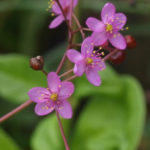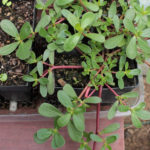Don’t you love it when you solve a mystery. I have an intriguing pretty plant in my garden that I
couldn’t identify. Finally a person with the App ‘Picture This’ revealed it as‘Jewels-of-Opar or Talinum paniculatum. I was totally delighted to learn this. It is also known as Fame Flower or Pink Babies Breath.
If you are a Tarzan fan you’ll probably have heard this name as Edgar Rice Burroughs in 1916 wrote ‘Tarzan and the Jewels of Opar’.It was also
mentioned in his second book ‘The Return of Tarzan’ written in 1913. Who or where is Opar? It may be based on an ancient African place called Ophir which held rich treasures of frankinsence and gold. Burroughs’ Opar is a fictional place holding a huge cache of gold and gems gleaned from doomed Atlantis. Tarzan ventures to Opar in order to claim some of the wealth. Some event, which seems as logical as a few of the plot twists of Tarzan and the Jewels of Opar, linked this Central American plant to a fictional African city. In any case, this charming plant was given the nickname ‘Jewels of Opar’.
I think this exotic name fits the succulent leaved
plant perfectly. It is adorned with tiny pink flowers spaced on an airy branched stem that last a long time opening and closing up each day, being loved by bees
and pollinating insects. Then the flowers are followed by small round red and earthy toned seed pods that look a bit like little beads or jewels spaced on the branches. These sprays of autumn colour can be dried and used in autumn bouquets or wreaths.
Jewels of Opar is a low growing plant of up to 20cm high by 30-40cm wide with succulent oval shaped leaves that are edible (always a bonus in my garden) with a pleasant fresh taste and not at all bitter. The main stem is also succulent and fleshy and my plant has bites taken out of it, no doubt
by snails. The flower stem grows up to 45cm tall.
It is native to Southern United States, Latin America and the Caribbean. Mine grows in a bed that gets shade in the afternoon. It is drought tolerant and is happiest and most productive in bright full sunshine. It love plants that self-sow readily and this ones pop up in different places in the same flower bed. You can easily pull out the plants if you don’t want them or move them to another location. It is said to be an annual but I find that it behaves more like a perennial. Our winters being pretty mild mean that the fleshy roots send up new leaves in spring. I had a Chinese horticultural student say she remembers eating the fleshy roots back in China and they call it false ginseng. I have not ventured to try eating the roots yet!
I’d be intrigued to hear if anyone else has or knows this plant. julia@juliasedibleweeds.com









Fascinating!! Thank you for this, learn something new every day.
I agree it was such a surprise and delight to learn about this plant and its connection to Tarzan!
Hi Julia, this is one of my favourite plants; such beautiful flowers and enchanting sed pods. While working in Brazil I discovered it and a couple of other Talinum species that also are quite charming. It is delicious to eat the new leaves in salads.
I also used it for green roofs as it is really drought resistant (3 or 4 months without rain in the dry season) When the rains arrive it quickly comes to flower and sets seed. I have also used it as an edging plant and as it has deep roots, it is great company for fruit trees as it brings up nutrients from below. They usually have a thin black skin over a white succulent root; much like comfrey (but not as strong or vital.
A few years ago I had some work in Africa (Senegal) and I discovered a specie of Talinum there on an island just off Dacar.
So the link with Africa in the story is probably true;
The treasure are its enchanting flowers.
If you like to think that there are fairies, I used to tell the kids that this is an indicator plant of where the fairies have their parties.
A treasure in any garden. I could never understand how nobody has it in their garden, and you never find it for sale. Its seeds are tiny and fit perfectly into the crack in city sidewalks and on the edges of highways; a real coloniser and nutrient accumulator.
Thanks for your lovely site
Love Pete
HI Peter, thank you SO much for your message and reply to the article. Wow how nourishing to read of your relationship with this special plant and thank you for all the information about where it can grow. I have friends about to create a roof garden and I will suggest it. I must grow some from seed. It is very enchanting and very hardy and I love how it will just pop up somewhere else. How cool to see it in Senegal and so the link with Africa sounds definitely more than fiction.
I love that you tell kids it is an indicator plant of where the fairies have their parties.
Thank you for purchasing my ebook and I’d love to know where you are located?? I see you are in Italy – how amazing!! Have you collected other Talinums where you are? I discovered that there’s a big public garden up near Auckland where they grow it. I must track that down further.
Thanks so much again for writing – you made my morning!!!